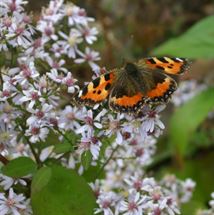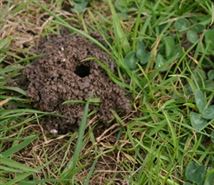
Bumblebees Active in Winter 2019/20
-
If you live in the southern half of the UK you may have seen bumblebees visiting winter-flowering shrubs on sunny winter days in recent years.
-
One species (the common Buff-tailed Bumblebee) consistently exhibits this behaviour and attempts to establish winter colonies, mainly in built-up areas where there are winter-flowering shrubs in gardens.
-
During the winter you can record your observations and submit them to the BWARS website (details below).
-
For information about other bees in winter jump to:
Where do bees go in winter?
The Bumblebee Year
There are now seven species of bumblebee commonly found in UK gardens, the so-called 'Big Seven'. Unlike honey bees, bumblebees have short-lived colonies and a nest typically lasts only a few months. At the end of the cycle young fertile females (queens) go into hibernation underground, and stay there for many months, to emerge the next spring when each will found a new colony.
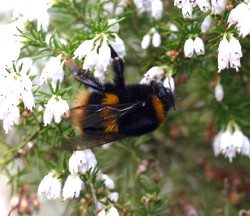 |
|
There should be a gap of at least three months between the last colonies dying out in autumn and the earliest emergence of young bumblebee queens from hibernation the next spring. One of the consistently early species in the spring is unsurprisingly called the 'Early Bumblebee' (Bombus pratorum). This species is also relatively small, with two yellow bands and an orange tail. Several other species will also make an appearance by March or April.
These include the very common 'Buff-tailed Bumblebee' (Bombus terrestris ssp. audax) illustrated left. Queens of this sub-species tend to be large and wide, with a pale peachy-buff coloured tail. They are distinctive and easy to recognise. Workers have a white tail. Sub-species audax is confined to Britain and Ireland. If you cross the Channel you will find that in Northern France B. terrestris queens have a white tail.
Foraging from Winter-flowering garden plants
Evidence from the last decade or so suggests that in some areas of the UK the Buff-tailed Bumblebee is able to maintain winter colonies in addition to its summer breeding cycle. It forages from autumn and winter-flowering plants growing in gardens. Prime amongst these are Arbutus (Strawberry Tree), and Clematis cirrhosa, from the Mediterranean area; Mahonia and winter-flowering honeysuckles such as Lonicera fragrantissima, from Eastern Asia; and Erica carnea, a winter-flowering heather from the European Alps. There are very few wild British plants that flower in the winter, and it seems that those that do (e.g. Gorse) do not provide sufficient or suitable forage to support winter bumblebee colonies. For this reason it is unlikely that winter colonies will survive in the open countryside away from gardens.
Favourite flowers of bumblebees in autumn and winter:
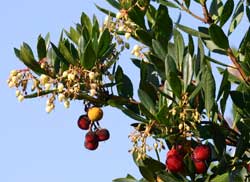 |
|
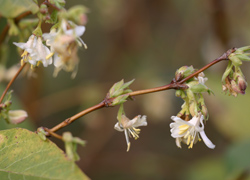 |
|
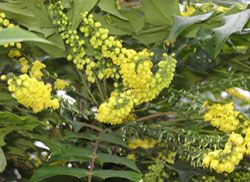 |
|
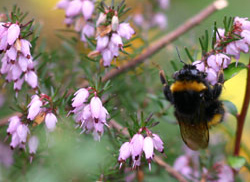 |
Arbutus unedo (Strawberry Tree) in October
Lonicera x purpusii (Winter Honeysuckle) in January
Mahonia hybrid in January.
Erica carnea (Winter flowering Heather) in February, with B.terrestris
There are many winter-flowering plants that the bees do not use as a regular forage source, or only visit as a last resort. These include Viburnum x bodnantense, Chimonanthus praecox, Jasminum nudicaule, Cornus mas, Iris unguicularis, and winter bedding plants such as pansies and polyanthus. This may be because these plants do not produce suitable nectar or pollen, or possibly it is inaccessible to the bees.
Bombus terrestris in Southern Europe
The winter nesting behaviour of the Buff-tailed Bumblebee in the UK may not be as aberrant as it first seemed. B. terrestris in a broad sense is widely distributed in Europe, and a number of sub-species have been recognised. In the Mediterranean area, the local sub-species exhibit regular autumn and winter breeding behaviour, which fits in the with the local climate and the availability of forage plants such as Arbutus unedo, A. andrachne and other autumn and winter-flowering species.
Is this a reaction to climate change?
Many kinds of insects in the UK have expanded their distribution northwards in the last 20 years, and it is generally thought that this is due to the pattern of milder winters we generally experienced during these decades. The winter breeding behaviour of the Buff-tailed Bumblebee is particularly interesting because it appears to be a change in behaviour, rather than a change in distribution. It is still hard to go beyond this and make firm statements about this phenomenon without the collection of much more data, over a wide area, over a number of years.
The first reference I have found to a winter bumblebee colony visiting the Strawberry tree, Arbutus unedo, dates in fact from 1957 (in The Speaking Garden by Edward Hyams) when winters were still consistently cold and what we consider to be recent climate change had not yet become apparent. So perhaps this phenomenon went on unrecorded for a long time simply because it was overlooked. It would be useful to find more references of winter bumblebees written in past decades. If you come across any, please contact me with details.
Should we all plant more winter flowering shrubs as food for bumblebees?
Not necessarily. B. terrestris is very common and is not a species of conservation concern in the UK. In fact if it can successfully breed in winter in the UK it might gain a competitive advantage over some of the other common bumblebee species, for example by monopolising potential nest sites early in the year, so that the other species might suffer. As yet we just don't know - we need more data, from more sites, collected over a number of years. This is where you can help.
How you can Contribute to Scientific Knowledge
The wild bee recording organisation BWARS (which has an excellent, informative website) collects details of sightings of winter-active bumblebees. If you see any winter bumblebees, please submit your data to the BWARS winter bumblebee page. Your records matter - this kind of data provides the evidence on which conservation strategies are based.
Additionally, a fact sheet about winter bumblebees is available from the bee conservation charity Hymettus. Many other factsheets about bees are available from the Hymettus and BWARS websites, including one about the new Tree Bumblebee B. hypnorum.
Other bumblebee recording, not of winter bumblebees, can also be done through various schemes operated by the Bumblebee Conservation Trust.
AN IMPORTANT WAY TO HELP BEES - GET OUT THERE AND START RECORDING!
How I got involved
I originally became interested in this subject in 2005, when I noticed bumblebee workers (non-reproductive females that forage for nectar and pollen) visiting an Arbutus (Strawberry Tree) in my garden in November and December. According to the books then available this was not possible, because bumblebee colonies die out in late summer and only individual young queens (fertile females) survive the winter in hibernation to found new colonies the following spring. The presence of worker bees on a regular basis suggested that there was an active nest nearby.
At that time I was studying Ecology and Conservation as a part-time student at Birkbeck College, University of London. I had to choose a dissertation subject and I decided to investigate the phenomenon of winter bumblebees. I collected data by regularly walking a 1km fixed route (transect) in the area of suburban London where I lived at the time, to record any observations of winter bumblebee activity in 2006/7. The exercise produced a lot of data.
I repeated the exercise the next winter, 2007/8. I was able to arrange a transect in Kew Gardens, which passed many winter-flowering plants. Again, this produced a lot of data. These data have been incorporated into a scientific paper.
Where do bees go in winter?
Bumblebees: Colonies die out at the end of the summer. Only young fertile females (queens) survive the winter, in hibernation in nooks and crannies under the ground, in a deep sleep. The winter-active bumblebee colonies described on this page are an exception to this rule, and seem to be a recent phenomenon in the UK, possibly involving only one of our 25 species. Will other bumblebee species adopt this behaviour? Will this phenomenon move northwards with climate change? This is where your observations are important.
Solitary Bees: All adults die as soon as their period of mating and nest building is over. For most species, this period is a window of activity lasting couple of months or so in spring or summer. Different species are active at different months, usually coinciding with the flowering of their main forage plants. Solitary bees' offspring survive the winter as mature larvae, pupae, or as dormant young adults (depending on species) in a state of suspended animation inside their nest cells. Again depending on species these can be holes or tubes in wood, dead stems, holes in sandy cliffs or in crumbly mortar, or holes or chambers underground.
Honeybees: These are a domesticated species and in the UK are now almost wholly dependent on human management. Colonies survive winter inside beehives and can last for several years with help from a beekeeper. Feral (i.e. non-managed) colonies left to their own devices (e.g. in hollow tree trunks) can also survive the winter but at present many of them seem weakened by the Varroa mite and less able to survive in the long term.
Back to Top
Last updated January 2020. © Marc Carlton 2006 - 2020. See 'About this Website' for terms of use.
